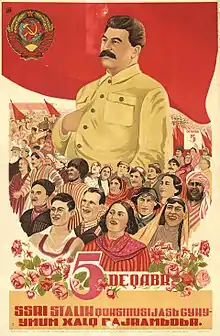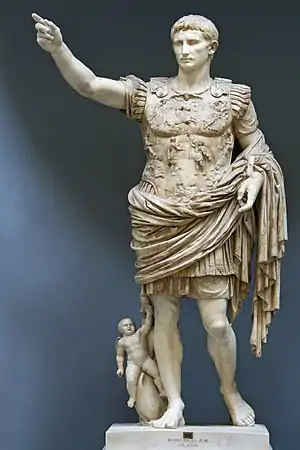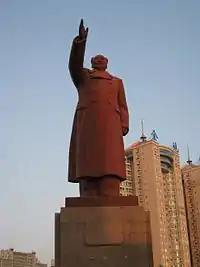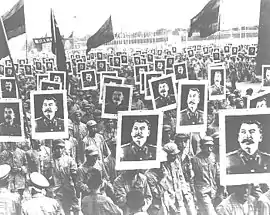Cult of personality
A cult of personality, or cult of the leader,[1] arises when a country's regime – or, more rarely, an individual – uses the techniques of mass media, propaganda, the big lie, spectacle, the arts, patriotism, and government-organized demonstrations and rallies to create an idealized, heroic, and worshipful image of a leader, often through unquestioning flattery and praise. A cult of personality is similar to apotheosis, except that it is established by modern social engineering techniques, usually by the state or the party in one-party states and dominant-party states. It is often seen in totalitarian or authoritarian countries.

The term came to prominence in 1956, in Nikita Khrushchev's secret speech On the Cult of Personality and Its Consequences, given on the final day of the 20th Congress of the Communist Party of the Soviet Union. In the speech, Khrushchev, who was the First Secretary of the Communist Party – in effect, the leader of the country – criticized the lionization and idealization of Joseph Stalin, and by implication, his Communist contemporary Mao Zedong, as being contrary to Marxist doctrine. The speech was later made public and was part of the "de-Stalinization" process in the Soviet Union.
Background

The Imperial cult of ancient Rome identified emperors and some members of their families with the divinely sanctioned authority (auctoritas) of the Roman State. Throughout history, monarchs and other heads of state were often held in enormous reverence and imputed super-human qualities. Through the principle of the divine right of kings, in medieval Europe for example, rulers were said to hold office by the will of God. Ancient Egypt, Imperial Japan, the Inca, the Aztecs, Tibet, Siam (now Thailand), and the Roman Empire are especially noted for redefining monarchs as "god-kings."
The spread of democratic and secular ideas in Europe and North America in the 18th and 19th centuries made it increasingly difficult for monarchs to preserve this aura. However, the subsequent development of mass media, such as radio, enabled political leaders to project a positive image of themselves onto the masses as never before. It was from these circumstances in the 20th century that the most notorious personality cults arose. Often these cults are a form of political religion,[2] and they may share some traits with other kinds of cult, especially while they are still forming.
The term "cult of personality" probably appeared in English around 1800–1850, along with the French and German use.[3] At first it had no political connotations but was instead closely related to the Romantic "cult of genius."[3] The political use of the phrase came first in a letter from Karl Marx to German political worker, Wilhelm Blos, 10 November 1877:[3]
Neither of us cares a straw of popularity. Let me cite one proof of this: such was my aversion to the personality cult [orig. Personenkultus] that at the time of the International, when plagued by numerous moves [...] to accord me public honor, I never allowed one of these to enter the domain of publicity [...][3][4]
Characteristics
.jpg.webp)
There are various views about what constitutes a cult of personality in a leader. Historian Jan Plamper has written that modern-day personality cults display five characteristics that set them apart from "their predecessors": The cults are secular and "anchored in popular sovereignty"; their objects are all males; they target the entire population, not only the well-to-do or just the ruling class; they use mass media; and they exist where the mass media can be controlled enough to inhibit the introduction of "rival cults."[5]
In his 2013 paper, "What is character and why it really does matter," Thomas A. Wright states, "The cult of personality phenomenon refers to the idealized, even god-like, public image of an individual consciously shaped and molded through constant propaganda and media exposure. As a result, one is able to manipulate others based entirely on the influence of public personality... the cult of personality perspective focuses on the often shallow, external images that many public figures cultivate to create an idealized and heroic image."[6]
Adrian Teodor Popan defines cult of personality as a "quantitatively exaggerated and qualitatively extravagant public demonstration of praise of the leader." He also identifies three causal "necessary, but not sufficient, structural conditions, and a path dependent chain of events which, together, lead to the cult formation: a particular combination of patrimonialism and clientelism, lack of dissidence, and systematic falsification pervading the society’s culture."[7][8]
The role of mass media
The mass media have played an instrumental role in forging national leaders' cults of personality.
Thomas A. Wright in 2013 reported that "It is becoming evident that the charismatic leader, especially in politics, has increasingly become the product of media and self-exposure."[6] And, focusing on the media in the United States, Robert N. Bellah adds that, "It is hard to determine the extent to which the media reflect the cult of personality in American politics and to what extent they have created it. Surely they did not create it all alone, but just as surely they have contributed to it. In any case, American politics is dominated by the personalities of political leaders to an extent rare in the modern world... in the personalised politics of recent years the 'charisma' of the leader may be almost entirely a product of media exposure."[9]
Purpose

Often, a single leader became associated with this revolutionary transformation and came to be treated as a benevolent "guide" for the nation without whom the transformation to a better future could not occur. This has been generally the justification for personality cults that arose in totalitarian societies, such as those of Adolf Hitler, Joseph Stalin, and Mao Zedong. The admiration for Mao Zedong has remained widespread in China. In December 2013, a Global Times poll revealed that over 85% of Chinese viewed Mao's achievements as outweighing his mistakes.[10] Jan Plamper argues while Napoleon III made some innovations in France it was Benito Mussolini in Italy in the 1920s who originated the model of dictator-as-cult-figure that was emulated by Hitler, Stalin and the others, using the propaganda powers of a totalitarian state.[11]
Pierre du Bois de Dunilac argues that the Stalin cult was elaborately constructed to legitimize his rule. Many deliberate distortions and falsehoods were used.[12] The Kremlin refused access to archival records that might reveal the truth, and key documents were destroyed. Photographs were altered and documents were invented.[13] People who knew Stalin were forced to provide "official" accounts to meet the ideological demands of the cult, especially as Stalin himself presented it in 1938 in Short Course on the History of the All-Union Communist Party (Bolsheviks), which became the official history.[14]
Historian David L. Hoffmann states "The Stalin cult was a central element of Stalinism, and as such it was one of the most salient features of Soviet rule... Many scholars of Stalinism cite the cult as integral to Stalin's power or as evidence of Stalin's megalomania."[15]
In Latin America, Cas Mudde and Cristóbal Rovira Kaltwasser link the "cult of the leader" to the concept of the caudillo, a strong leader "who exercises a power that is independent of any office and free of any constraint." These populist strongmen are portrayed as "masculine and potentially violent" and enhance their authority through the use of the cult of personality. Mudde and Kaltwasser trace the linkage back to Juan Peron of Argentina.[1]
States and systems with personality cults
Argentina
Juan Perón, elected three times as President of Argentina, and his second wife, Eva "Evita" Perón, were immensely popular among many of the Argentine people, and to this day they are still considered icons by the leading Justicialist Party. Academic and detractors often considered him a demagogues and a dictator. Peron sympathised with the Axis powers when he was a colonel and Minister of War[16] and even served as a diplomatic envoy to Fascist Italy. During his regime he kept close ties with Francoist Spain. He ferociously persecuted dissents and potential political rivals as political arrest were common during his first two terms, he eroded the republican principles of the country as a way to stay in power and forced state wide censorship on most media.[17] Following his election he built a personality cult around both himself and his wife so pervasive it is still a part of Argentina's current political life. [18] During his regime schools were forced to read Evita's biography La Razón de mi Vida, union and government jobs were only given to those who could prove themselves to be a fervent Peronist, newspapers were censored and television and radio networks were nationalised, only state media was allowed. He often showed contempt for any opponents; and regularly characterised them as traitors and agents of foreign powers; Those who didn't fall in line or were perceived as a threat to Perón's political power where subject to losing their jobs, threats, violence and harassment. Perón fired over 20000 university professors and faculty members from all major public education institutions.[19] Universities were then intervened, the faculty was pressured to get in line and those who resisted where blacklisted, fired or exiled. Numerous prominent cultural and intellectual figures were imprisoned.[20] Thousands of artists, scientists, writers and academics left the country, migrated to North America or Europe. Union leader and political rivals were arrested and tortured for years[21][22] and were only released after Perón was deposed.[23]
Fascist Italy

Benito Mussolini was portrayed as the embodiment of Italian Fascism and was keen to be seen as such.[24] Mussolini was styled by other Italian fascists as Il Duce ("The Leader"). Since Mussolini was represented as a god who knew every thing, a common saying in Italy during Mussolini's rule was "The Duce is always right." (Italian: Il Duce ha sempre ragione).[25] Mussolini became a unifying force in Italy in order for ordinary Italians to put their difference to one side with local officials. The personality cult surrounding Mussolini was a way that he could justify his personal rule and it acted as a way to enable social and political integration.
Mussolini's military service in World War I and survival of failed assassination attempts were used to convey a mysterious image about him.[26] Fascist propaganda stated that Mussolini's body had been pierced by shrapnel just like St. Sebastian had been pierced by arrows; the difference being that Mussolini had survived this ordeal.[26] He was also compared to St. Francis of Assisi, who had, like Mussolini, "suffered and sacrificed himself for others".[27]
The press were instructed about what to write about Mussolini.[24] Mussolini himself authorised which photographs of him were allowed to be published and rejected any photographs which made him appear weak or less prominent than he wanted to be portrayed as in a particular group.[28]
Italy's war against Ethiopia (1935–37) was portrayed in propaganda as a revival of the Roman Empire, with Mussolini as the first Roman emperor Augustus.[29] To improve his own image, as well as the image of Fascism in the Arab world, Mussolini declared himself to be the "Protector of Islam" during an official visit to Libya in 1937.[30]
Nazi Germany

Starting in the 1920s, during the early years of the Nazi Party, Nazi propaganda began to depict the Nazi leader Adolf Hitler as a demagogue figure who was the almighty defender and saviour of Germany. After the end of World War I and the Treaty of Versailles, the German people were left in turmoil under the Weimar Republic and according to Nazi propaganda, only Hitler could save them and restore Germany's greatness which in turn gave rise to the "Führer-cult".[31] During the five election campaigns in 1932, the Nazi newspaper Völkischer Beobachter portrayed Hitler as a man who had a mass movement united behind him, a man with one mission to solely save Germany as the 'Leader of the coming Germany'.[32]
Nazi Propaganda Minister Joseph Goebbels cultivated an image of Hitler as a "heroic genius".[31] The myth also gave rise to the saying and concept, "If only the Führer knew", in reference to what Germans thought were wrongdoings and if Hitler knew then he would set things right and act accordingly; the Night of the Long Knives in 1934 helped to reinforce it.[33]
British historian Ian Kershaw published his book The "Hitler Myth": Image and Reality in the Third Reich in 1987 and wrote:
Hitler stood for at least some things they [German people] admired, and for many had become the symbol and embodiment of the national revival which the Third Reich had in many respects been perceived to accomplish.[34]
During the early 1930s, the myth was given credence due to Hitler's perceived ability to revive the German economy during the Great Depression. However, Albert Speer wrote that by 1939, the myth was under threat and the Nazis had to organise cheering crowds to turn up to events. Speer wrote:
The shift in the mood of the population, the drooping morale which began to be felt throughout Germany in 1939, was evident in the necessity to organize cheering crowds where two years earlier Hitler had been able to count on spontaneity. What is more, he himself had meanwhile moved away from the admiring masses. He tended to be angry and impatient more often than in the past when, as still occasionally happened, a crowd on Wilhelmsplatz began clamoring for him to appear. Two years before he had often stepped out on the "historic balcony." Now he sometimes snapped at his adjutants when they came to him with the request that he show himself: "Stop bothering me with that!"[35]
The myth helped to unite the German people during World War II, especially against the Soviet Union and the Western Allies. During Hitler's early victories against Poland and Western Europe the myth was at its peak, but when it became obvious to most Germans that the war was lost then the myth was exposed and Hitler's popularity declined.
A report given in the little Bavarian town of Markt Schellenberg on 11 March 1945:
When the leader of the Wehrmacht unit at the end of his speech called for a Sieg Heil for the Führer, it was returned neither by the Wehrmacht present, nor by the Volkssturm, nor by the spectators of the civilian population who had turned up. This silence of the masses ... probably reflects better than anything else, the attitudes of the population.[36]
North Korea
Soviet Union

After Vladimir Lenin's death and the exile of Leon Trotsky, Joseph Stalin came to embody the Soviet Union. In December 1929, Stalin celebrated his 50th birthday which made Stalin become a prominent feature in the Soviet press.[37] The Soviet press used positive adjectives like, "Great", "Beloved", "Bold", "Wise", "Inspirer", and "Genius" to describe him.[38] Similarly, speeches that were given by people to the peasants described Stalin as "Our Best Collective Farm Worker", "Our Shockworker, Our Best of Best", and "Our Darling, Our Guiding Star".[38] After 1936, the Soviet press described Stalin as the "Father of Nations".[39]
One key element of Soviet propaganda was interactions between Stalin and the children of the Soviet Union. He was often photographed with children of different ethnic backgrounds of the Soviet Union and was often photographed giving gifts to children. In 1935 the phrase, "Thank You Dear Comrade Stalin for a Happy Childhood!" started to appear above doorways at nurseries, orphanages, and schools; children also chanted this slogan at festivals.[40]
See also
References
Notes
- Mudde, Cas and Kaltwasser, Cristóbal Rovira (2017) Populism: A Very Short Introduction. New York: Oxford University Press. p. 63. ISBN 978-0-19-023487-4
- Plamper (2012), pp. 13–14
- Heller, Klaus (2004). Personality Cults in Stalinism. Isd. pp. 23–33. ISBN 978-3-89971-191-2.
- Blos, Wilhelm. "Brief von Karl Marx an Wilhelm Blos". Denkwürdigkeiten eines Sozialdemokraten. Retrieved 22 February 2013.
- Plamper (2012), p. 222
- Wright, Thomas A.; Lauer, Tyler L. (2013). "What is character and why it really does matter". Fordham University: Business Faculty Publications. 2: 29. Retrieved 13 June 2019.
- See Popan, Adrian Teodor (2015) The ABC of Sycophancy. Structural Conditions for the Emergence of Dictators’ Cults of Personality (PhD dissertation, University of Texas). Bibliography pp. 196–213.
- Popan, Adrian Teodor (August 2015). "The ABC of sycophancy : structural conditions for the emergence of dictators' cults of personality" (PDF). University of Texas at Austin. doi:10.15781/T2J960G15. hdl:2152/46763. Cite journal requires
|journal=(help) - Bellah, Robert N. (1986). "The Meaning of Reputation in American Society". California Law Review. 74 (3): 747. doi:10.15779/Z386730. Retrieved 13 June 2019.
- Staff (23 December 2013). "Mao's achievements 'outweigh' mistakes: poll". al-Jazeera.
- Plamper (2012), pp. 4, 12–14
- du Bois, Pierre (1984). "Stalin – Genesis of a Myth". Survey. A Journal of East & West Studies. 28 (1): 166–181. See abstract in David R. Egan; Melinda A. Egan (2007). Joseph Stalin: An Annotated Bibliography of English-Language Periodical Literature to 2005. Scarecrow Press. p. 157. ISBN 978-0810866713.
- Strong, Carol; Killingsworth, Matt (2011). "Stalin the Charismatic Leader?: Explaining the 'Cult of Personality' as a legitimation technique". Politics, Religion & Ideology. 12 (4): 391–411. doi:10.1080/21567689.2011.624410. S2CID 144628885.
- Maslov, N. N. (1989). "Short Course of the History of the All-Russian Communist Party (Bolshevik) – An Encyclopedia of Stalin's Personality Cult". Soviet Studies in History. 28 (3): 41–68. doi:10.2753/RSH1061-1983280341.
- Hoffmann, David L. (2013). "The Stalin Cult". The Historian. 75 (4): 909. doi:10.1111/hisn.12023_65. S2CID 145070443.
- Neighbor Accused, TIME Magazine, February 18, 1946
- Martínez, Tomás Eloy (20 January 1997). "The woman behind the fantasy. prostitute, fascist, profligate – Eva Perón was much maligned, mostly unfairly". Time. Archived from the original on 21 December 2001. Retrieved 28 January 2009.
- Politics and Education in Argentina, 1946–1962, by Mónica Esti Rein; trans by Martha Grenzeback. Published by M. E. Sharpe, Armonk, NY/London, 1998, pp. 79–80.
- Rock, David (1987). Argentina, 1516–1982. University of California Press.
- "Palermo online". Palermonline.com.ar. Retrieved 27 January 2011.
- Pigna, Felipe. "Ricardo Balbín". Elhistoriador.com.ar (in Spanish). El Historiador. Archived from the original on 2011-11-28. Retrieved 14 December 2020.
- Feitlowitz, Marguerite (2002). A Lexicon of Terror: Argentina and the Legacies of Torture. Oxford University Press.
- "Clarín". Clarin.com. Retrieved 27 January 2011.
- Hamilton 1973, p. 73.
- Bosworth 2006, p. 3.
- Falasca-Zamponi 2000, pp. 72–73.
- Falasca-Zamponi 2000, pp. 65–66.
- Gallo 1973, pp. 206–207.
- Brendon 2016, p. 329.
- Williams 2006, p. 112.
- "The Führer Myth How Hitler Won Over the German People". Der Spiegel. 30 January 2008.
- Kershaw 1998, pp. 36–37.
- Kershaw 1998, p. 95.
- Kershaw 1998, p. 71.
- Speer 2009, p. 158.
- Kershaw 2001, p. 766.
- Gill 1980.
- Gunther 1936, pp. 516–517, 530–532, 534–535.
- "Joseph Stalin's Cult Of Personality". History Collection.
- Kelly 2005, pp. 206–207.
Bibliography
- Bosworth, Richard J. B. (2014). Mussolini. A&C Black. ISBN 978-1-84966-024-2.
- Bosworth, Richard J. B. (2006). Mussolini's Italy: Life Under the Dictatorship, 1915–1945. Penguin Adult. ISBN 978-0-14-101291-9.
- Brendon, Piers (2016). The Dark Valley. Random House. ISBN 978-1-4464-9632-9.
- Falasca-Zamponi, Simonetta (2000). Fascist Spectacle: The Aesthetics of Power in Mussolini's Italy. University of California Press. ISBN 978-0-520-22677-7.
- Gallo, Max (1973). Mussolini's Italy; Twenty Years of the Fascist Era. Macmillan.
- Gill, Graeme (1980). "The Soviet Leader Cult: Reflections on the Structure of Leadership in the Soviet Union". British Journal of Political Science. 10 (167): 167–186. doi:10.1017/S0007123400002088.
- Gundle, Stephen; Duggan, Christopher; Pieri, Giuliana (2015). The cult of the Duce: Mussolini and the Italians. Manchester University Press. ISBN 978-1-5261-0141-9.
- Gunther, John (1936). Inside Europe. Harper & brothers.
- Hamilton, Alastair (1973). Appeal of Fascism. Harper Mass Market Paperbacks (Mm). ISBN 978-0-380-01025-7.
- Kelly, Catriona (2005). "Riding the Magic Carpet: Children and Leader Cult in the Stalin Era". The Slavic and East European Journal. 49 (2): 199–224. doi:10.2307/20058260. JSTOR 20058260.
- Kershaw, Ian (2001). Hitler 1936-1945: Nemesis. Penguin Books Limited. ISBN 978-0-14-192581-3.
- Kershaw, Ian (1998). The 'Hitler Myth'. Image and Reality in the Third Reich.}}
- Plamper, Jan (2012). The Stalin Cult: A Study in the Alchemy of Power. New Haven, Connecticut: Yale University Press. ISBN 978-0300169522.
- Speer, Albert (2009). Inside The Third Reich. Orion. ISBN 978-1842127353.
- Williams, Manuela (2006). Mussolini's Propaganda Abroad: Subversion in the Mediterranean and the Middle East, 1935–1940. Taylor & Francis. ISBN 978-0-203-00477-7.
Further reading
- Apor, Balázs; Behrends, Jan C.; Jones, Polly; and Rees, E. A. (2004) eds. The Leader Cult in Communist Dictatorships: Stalin and the Eastern Bloc. London: Palgrave Macmillan. ISBN 1403934436.
- Dikötter, Frank (2020). Dictators: The Cult of Personality in the Twentieth Century. London: Bloomsbury Publishing. ISBN 978-1-5266-2698-1.
- Cohen, Yves (2007). "The cult of number one in an age of leaders". Kritika: Explorations in Russian and Eurasian History. 8 (3): 597–634. doi:10.1353/kri.2007.0032. S2CID 144730066. Retrieved 7 September 2018.
- Gill, Graeme (1984). "Personality cult, political culture and party structure". Studies in Comparative Communism. 17 (2): 111–121. doi:10.1016/0039-3592(84)90008-5.
- Heller, Klaus and Plamper, Jan eds. (2004) Personality Cults in Stalinism/Personenkulte im Stalinismus. Göttingen: V&R Unipress. ISBN 3899711912. 472 pp
- Melograni, Piero (1976). "The Cult of the Duce in Mussolini's Italy" (PDF). Journal of Contemporary History. 11 (4): 221–237. doi:10.1177/002200947601100411. S2CID 150787157. Retrieved 7 September 2018.
- Morgan, Kevin (2017) International Communism and the Cult of the Individual Leaders, Tribunes and Martyrs under Lenin and Stalin. London: Palgrave Macmillan. ISBN 978-1349953370
- Paltiel, Jeremy (1983). "The Cult of Personality: Some Comparative Reflections on Political Culture in Leninist Regimes". Studies in Comparative Communism'. 16 (1–2): 49–64. doi:10.1016/0039-3592(83)90043-1.
- Petrone, Karen (2004) "Cult of Personality" in Millar, J. R. ed. Encyclopedia of Russian History, v. 1, pp. 348–350
- Polese, Abel; Horák, Slavomir (2015). "A tale of two presidents: personality cult and symbolic nation-building in Turkmenistan". Nationalities Papers. 43 (3): 457–478. doi:10.1080/00905992.2015.1028913. S2CID 142510277.
- Rutland, P. (2011) "Cult of Personality" i. Kurian, G. T. ed, The Encyclopedia of Political Science. Washington. D.C.: CQ Press. v. 1, p. 365
- Tucker, Robert C. (1979). "The Rise of Stalin's Personality Cult" (PDF). American Historical Review. 84 (2): 347–366. doi:10.2307/1855137. JSTOR 1855137. Retrieved 7 September 2018.
- Vassilev, Rossen (2008) "Cult of Personality" in Darity, W. A., Jr. ed. International Encyclopedia of the Social Sciences.
External links
- Why Dictators Love Kitsch by Eric Gibson, The Wall Street Journal, August 10, 2009